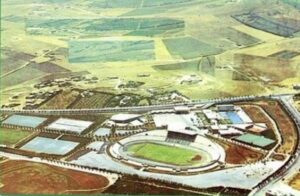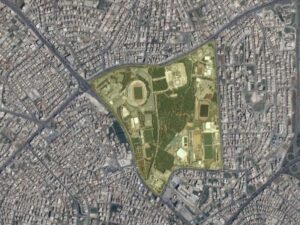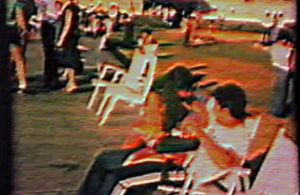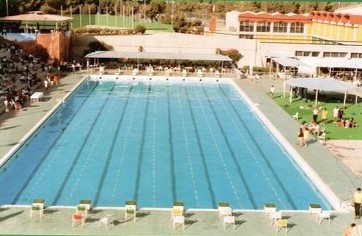The Old Amman and its il-Madineh
At a small dinner party a few years ago in Beirut, I met George Arbid, then professor of Architecture at AUB and co-founder of the Arab Center for Architecture (ACA). He told me he was working on a region-wide project on monuments to modernity in Arab metropolises–or something to that effect. They had chosen, for example, Beirut’s Electricté du Liban building which epitomized the city’s “‘golden age’ for planning, architectural visions and local trajectories.”
He had just learned about my Jordanian roots and started to tell me they “were struggling to…”–and I pounced: “The Sports City, without a doubt.” If there’s a structure in Amman that embodies the most aspirational vision of itself, it’s il-Madineh.
Bird’s eye shots of the il-Madineh compound in the 1970s and now
I have long marveled at how the Sports City’s transformations over the decades danced to the rhythms of Amman’s. Since its very first days in 1972, il-Madineh swayed to the city’s yearnings for hope and renewal in the aftermath of the 1967 Arab-Israeli War and the ensuing 1970-71 Civil War. It responded to our need to mend our wounds and our flirtations with a live-and-let-live way of life: mild, accepting, open, simple, and unafraid of fun. Paths were being carved for Amman, indeed for Jordan, in that crucial decade. Some ran parallel, some collided, others overlapped. In the end, for so many reasons, Amman let go of this promising vision of itself, and so did il-Madineh.
Alas, I don’t have photos of that time, just a battered old film taken by me one lovely summer day in 1976 to record my brother Fadi competing in the 400-meter free style national race. I see him and other friends competing. I see the crowds everywhere on the Roman-like steps and on the grass. I see Fadi and my father for a fleeting few seconds talking, the sun behind them, perhaps discussing Fadi’s aquatic triumph. I see our friends clowning around on the grass after the celebrations. Youth at its most wonderous before life’s hardships intruded on us, on Amman, on our City .
Summer 1976
It has long been lost to me, il-Madineh. It’s lost to us all–we its original inhabitants. I wouldn’t even know how to reach it in the maze of crisscrossing highways and streets and stone and concrete. Amman itself has become a bit of a stranger to me. I have long been a Beiruti. There were around 500,000 of us Ammanis in 1975. Now, we top four million. It used to take five minutes to get from our home in Shmeisani to the Sports City. I hear today it feels like an eternity.
Inside the Sports City
****
Excerpt from Chapter One: Awkward Amities
I was eleven and it was the summer of 1973. Jordan’s King Hussein had come for lunch in the upper restaurant of the Sports City. In those days, el-Madineh, or the City, as we called it for short, was life itself between June and September in Amman. It offered opportunities for leisure, wellbeing, and culture within a sprawling compound of greenery, swimming pools, restaurants, an amphitheater for plays and concerts, and courts for every imaginable sport. There, after the 1970 bloody conflict between the Palestine Liberation Organization (PLO) and the Kingdom, we went to heal and be carefree. There, we learned how to swim and dive and kiss; how to play basketball, Trumps, ping-pong, and Truth or Dare. There, we paraded in our shorts and bikinis, the boys in their Speedos, Mark Spitz their hero. On the Roman-like amphitheater overlooking the three pools, the grass lawns, and the restaurants beyond we sang to Paul Anka’s “Papa,” Charlie Rich’s “The Most Beautiful Girl,” and Dolly Parton’s “Jolene.” On the grass, our hearts broke only to flutter again. To this day, I have my membership card: 430.
Soon after lunch, the king appeared on the balcony, waved, and then descended to take a stroll. The crowds went mad. The young maidens in love, swooning with tears in their eyes, were a sight to behold. I hadn’t seen him in person before. His signed photos to my father hung in our living room, though. I knew that my family had a safe home in Jordan because of him. I knew that, at his request, my father established the national airline when he first decamped to Amman in 1962; that they shared a passion for aviation; that they saw each other often. I knew all this, but I didn’t know the king

A multitude immediately formed around the Hashemite monarch and his bodyguards. As was his habit, he was all ease, twinkles, and smiles. I was still very short then and scrawny. I slinked my way in between hips and thighs and found myself right beside him. We strode together for a while as the mob jostled us left and right, and every time he reached out to shake someone’s hand, I planted my own first in his palm. I swaggered for the rest of that afternoon in triumph.
That day at el-Madineh occupies the very first page in my journal. There is an old home movie feel to that memory—a two-minute, silent clip of bygone years. This was not my intention. Regret more than nostalgia, if you ask me, as if I am freezing history in one scene, in the hope that it might suggest a truth much larger than its tiny self. I have many of these: a thick album of rueful “once-upon-a-times.”
…They tug at my heart, these “once-upon-a-times,” not because of the passage of time and the vanishing of an old world that was supposedly better, but because when I look back, I realize that what I lived and loved was just one scenario that had lost out to others. And I wonder to myself, what role had I played in this unforgivable lapse?
****
On Another Note
Have you ever heard of the Palestinian photographer Karimeh Abboud? When she travelled all over Palestine early in the 20th century clicking away at her camera, she didn’t know she would be documenting a land and a people whose very existence would soon be questioned. Her photographs are now on display in the Museum of Islamic and Near Eastern Cultures in Be’er Sheva, of all places.
This one is my favorite.

Hilary Mantel has left us. An extraordinarily sad moment for lovers of literature and historical fiction. Counterintuitively, I share here her 2006 review in the New York Review of Books of Pankaj Mishra’s Temptations of the West: How to Be Modern in India, Pakistan, Tibet, and Beyond.
This is a book written for the West, by a man with a stake in two worlds, who moves through languages—a skill of which Mishra makes little—and who travels uneasily, so that most of us can stay at home. For the West it makes bitter reading. It explores a legacy of bungling and bad faith, of cultural incomprehension and pragmatic exploitation, and the export of two ideas—the idea of the nation-state and the idea of democracy—which have arrived in the East in a deteriorated and contaminating condition.
Beautiful! Rest in Peace, Hilary Mantel, you will be sorely missed.






